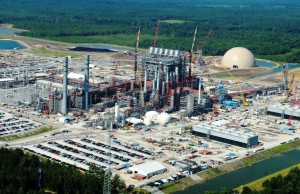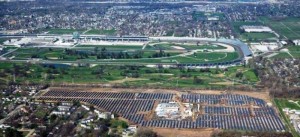July 2014 – Volume 16, Issue 5: The Food Revolution
IN THIS ISSUE
Flanigan’s Eco-Logic
Making Cars of Recycled Materials
Presidential Action and the War on Coal
Elon Musk’s Latest Terrestrial Moves
Organic Food Industry Statistics
Indianapolis Makes Solar Waves

Flanigan’s Eco-Logic: The Food Revolution
This issue touches on the U.S. Environmental Protection Agency’s big step to mandate the reduction of emissions, state by state. It’s about what some call the “the war on coal.” The issue also covers making cars of recycled materials, Elon Musk’s remarkable contributions on land, the Indy 500 and more. But let’s begin with food… an undeniably critical resource!
The organic food movement in America parallels the rise of distributed generation in America. Organics are now at 4%; household solar – even here in California — hovers at about 1%. Fully 142,595 households in California have turned their rooftops into clean power plants. Both organics and decentralized solar are in the single digits of penetration, but are gaining popularity for good reason, and growing fast.
Some years ago I was happy as a clam travelling around the country in my used Nissan pickup, topped with camper, and complete with girlfriend, guitar, and dog. It was my version of “Travels with Charlie.” Dedicated vegetarians, always at the ready was our trusted directory of food co-ops and health food stores, listed state by state across the country. In many cases, they were very few are very far between. I kept the directory beneath the driver’s front seat… alongside the repair manual for the truck. These were essentials.
The natural food directory led us to oases where we could buy peanut butter without sugar, Tom’s toothpaste, seitan, fresh tofu, soy milk, and so much more. The co-ops were meeting places; their bulletin boards brimming with community events, yoga, ride-sharing, etc. No doubt, it was expensive. We paid a painful premium for healthy food then. But we were loath to fill our bodies with pesticides, herbicides, fungicides, growth hormones, and more.
Today the organic food movement has blown well past “natural” foods. The “certified organic” food movement is alive and well representing a 4% market share. Organic food sales continue to grow in leaps and bounds. In 1990, ten years after our cross-country treks, the entire U.S. organic food industry was just $1 billion in size. Today, it is nearly 30 times that… and organic is everywhere. It’s not just in small natural food stores, but front and center in supermarkets and big box stories. It has come of age and may well be over the tipping point.
There’s a parallel between healthy food systems and healthy energy systems. Just as we have witnessed the rise of organic foods – think Whole Foods – we have witnessed the rise of solar power in the form of “DG” or distributed generation – think SolarCity. Rather than relying on agribusinesses and centralized power plants, society is turning toward decentralized food and power production, community supported agriculture and microgrids, edible landscapes and building integrated photovoltaics. It’s happening at the household and neighborhood scale, food and power production that is cleaner, healthier, and more resilient. Both movements are on the rise and on the same trajectory in time.
Quote of the week:
“The cost compression potential is quite high if you are willing to go all the way down the supply chain.”
– Elon Musk on the Gigafactory for Batteries
Making Cars of Recycled Materials

Some Ford seats are made from soybeans
Once again, the Ford Motor Company is taking the sustainability of its automobile components very seriously: Soybean oil is being used to make seat cushions, tomato skins are being processed for floor mats, Ford is even in the early stages of a deal to mold shredded U.S. currency into coin trays. It is strategically deploying non-petroleum based alternatives to traditional plastics. Doing so will result in less weight and increased fuel economy. Furthermore, using inexpensive, environmentally-friendly natural materials that otherwise would end up in landfills just makes sense.
Imagine recycled water bottles in seat covers, wheat straw in plastic storage bins, dashboards made of blue-jeans, t-shirts and sweaters. Sure, there’s recycled wood for interior trim, and recycled yarn. Ford engineers are even working toward the use of a pulp of marigolds and dandelions to a non-petroleum based rubber for auto trim and tires.
Back to the future? Perhaps. Ford’s founder, Henry Ford, was enamored by the use of plant materials. He used hemp fiber and wheat straw in early automotive components, and he wore a suit of made of soybean wool. Ford even made a prototype car of soybean oil-based plastics in 1941 that weighed 1,000 pounds less than a similar car at the time. Furthermore, he pointed out, its panels didn’t dent or ding.
Ford is not the only major taking major steps. Honda is working on a bio-fabric that is corn based, suitable for seating materials, and a byproduct of sugar cane for plastic. Toyota has been using recycled plastic in a number of vehicles since 2007, and kenaf plant fibers for scuff plates and bamboo charcoal for the manufacture of its speaker cones.
Presidential Action and the War on Coal

Clean coal technology in Mississippi
It’s a blow to the coal industry. Considered one of capstones of President Obama’s Climate Action Plan, on June 2 the U.S. Environmental Protection Agency proposed stringent state-specific rules for carbon emissions to amend Section 111(d) of the Clean Air Act. The nation’s aging coal-fired power plants are front and center of the rulemaking.
At stake is a major transition, from an electricity portfolio dominated by coal, to one dominated by clean technologies. Hundreds of thousands of jobs in the coal industry will be cut, while clean technology will rise to become the dominant power paradigm. Already, the EPA’s 2011 Mercury and Air Toxic Standards have caused utilities to take action. They have four years to comply. By the end of 2012, 14,000 MW of coal-fired capacity had been retired. The Sierra Club’s Beyond Coal campaign posts a tally of 168 retired plants (including planned retirements) with 355 more to go.
The EPA’s proposed rule – called the Clean Power Plan — requires states to develop and adopt plans to cut emissions by 30% in aggregate from 2005 levels by 2030. EPA’s final rulemaking is expected mid-2015, with plans due mid-2016. Note that differing levels of reductions are required for each state. And those states that do not do so within a year will be provided plans by the EPA.
In addition to CO2 mitigation, the proposed rule will result in correspondingly fewer “co-pollutants” such as sulfur dioxide, mercury, and nitrous oxides in the atmosphere. It is anticipated that the new rules will result in 2,700 – 6,600 fewer premature deaths, and avoid up to 150,000 cases of childhood asthma attacks, resulting in $93 billion in public health benefits.
Analysts believe the proposed rule is a bonanza for natural gas and gas-fired plants, and a bust for the domestic coal industry and utilities that have relied on this source of generation for years. For states that seek to build additional capacity, new coal plants will have to achieve an emissions level of 1,100 pounds of carbon dioxide per megawatt hour, a level possible only with the most advanced coal technologies combined with costly carbon capture and storage.
The Natural Resources Defense Council calls this “the super bowl of climate politics.” Yes, power plants are the single largest contributor of greenhouse gas emissions, responsible for ~38% of the nation’s total. (Transportation is 32%.) And yes, coal-fired power plants generated 45% of the nation’s electricity in 2010. According to the Sierra Club, of the 963 coal-fired units operating in late 2013, 523 or 65% are at least 40 years old. Many were built when Eisenhower was president. They lack advanced technologies and are prime opportunities for GHG reductions.
Not so fast says the coal industry. According to the World Coal Association, coal provides around 30% of global primary energy needs, generates 41% of the world’s electricity and is used in the production of 70% of the world’s steel. Coal reserves are sufficient for more than 100 years at the current rate of production. In December 2012, the International Energy Agency projected coal to come close to surpassing oil as the world’s main energy source by 2017. Since the tightening of regulations on coal-fired generation in America, exports have doubled, from 58 million tonnes in 2010 to 118 million tonnes in 2012.
EPA’s proposed rulemaking will regulate carbon emissions from existing power plants under Section 111(d) of the 1990 Clean Air Act Amendments. Using a complex methodology, states have been assigned varying goals by the EPA based on their stock of power plants, anticipated plant closures, and programs to promote renewables. Some states claim that they will not have to close additional coal-fired plants to meet their specified targets while others are already claiming hardship in compliance.
Some call the EPA’s rules mysterious: Texas emits more CO2 than any other state, 232.3 million tonnes of CO2 in 2012. Washington is one of the smallest annual emitters at 6.1 MMT. But Texas has to cut its emissions by 39% while Washington has to cut its emissions by 72%. Furthermore, Washington’s average power plant emission rate is the fifth lowest in the nation, at 763 pounds of CO2 per MWh (after California, Maine, Idaho, and Vermont).
Some say that the date EPA published its proposed rule marked the beginning of a new era for state energy and environmental regulators. It places responsibility clearly on the states. Some claim that the proposal reflects “unprecedented, comprehensive, and flexible integration of energy and environmental policy.” It relies on essential “building blocks” – such as robust DSM programs and retiring plants – to achieve the specific state and aggregate reductions. It will require states to plan and execute emissions reductions strategies to achieve stated goals.
EPA’s proposed ruling affords states a variety of options to meet the goals, such as increasing power plant efficiency, switching from coal to natural gas, increasing renewable energy usage, and increasing end-use energy efficiency. Under the proposal, “outside the fence” emissions reductions such as energy efficiency and renewable energy are also fair game. Carbon markets – buying offsets – can also be used.
An interesting development creates an unlikely marriage between the coal and oil industries. New EPA rules have loosened restrictions pertaining to drinking water and CO2 injection. Given EPA rules to ratchet back CO2 emissions, coal-fired power plants are now capturing CO2 and re-injecting it back into the Earth for enhanced oil recovery. Critics point out that for every 1 tonne of CO2 captured, 4 tonnes will be released when the oil is burned. So far, there are four coal-fired plants in the United States that are shunting their gases to enhanced oil recovery. DeKalb, Mississippi is home to America’s cleanest burning and most expensive coal-fired power plant. Its gases are captured and injected for enhanced oil recovery.
Elon Musk’s Latest Terrestrial Moves

Gigafactory rendering
It’s hard not to watch in awe and appreciation. South Africans taking on the U.S. by storm, and transforming space travel, cars, and who’s in charge of how our homes and businesses are powered. Elon Musk – the billionaire founder of PayPal – is at the helm of SpaceX and Tesla Motors Inc. In 2006 Musk presented the SolarCity business model to his cousins, Peter and Lyndon Rive. They took it on. Musk – the company’s biggest investor and owner – remains chairman. By 2012, Solar City had 2,500 employees and 110,000 customers.
Space X, a private “space launch vehicle company,” is making headlines, now carrying payloads for NASA, cargo resupply runs to the International Space Station. Most recently, it achieved certification from the Air Force to bid to service the highly lucrative Evolved Expendable Launch Vehicle program, launching the Pentagon’s most precious satellites into orbit. Previously the Air Force had certified only one company for this, a combined Boeing and Lockheed Martin group, which has successfully launched 71 times.
On Earth, Musk and his colleagues at Tesla and SolarCity are on parallel paths seeking to control production of batteries for both cars and solar system storage devices, and solar cells, to “compress” costs.
Tesla is seeking to build a “gigafactory” for batteries to control production capacity. Elon Musk believes that the factory will be able to drive down the costs of batteries by at least 30%. The batteries will be used for Teslas (a major component of Musk’s strategy to make EVs more affordable), as stationary battery packs for SolarCity’s energy storage systems, and will be available for purchase by other EV manufacturers.
Musk also recently made news when he announced that Tesla’s hundreds of patents that decorate the walls of Tesla’s Palo Alto headquarters, are now open source. With EVs less than 1% of the automotive market, Musk believes that it will benefit the entire EV industry if his rivals have access to the same ground-breaking technologies: “They have been removed in the spirit of an open source movement, for the advancement of the electric vehicle technology.”
SolarCity is making big news as it seeks to compress the costs of solar cells. Its $200 million purchase of start-up PV cell manufacturer Solevo signals a move to develop a 1 GW per year solar cell production company, outstripping the production of its 32 MW per year PV manufacturing plant in China. Solevo is a start-up company that has proven exceptional efficiency. Its panels are 21% efficient with the promise to increase to 24% while the industry average is 17%.
In related news, Qatar Solar Energy (QSE) announced that it is progressing in its effort to build at 2.5 GW solar PV manufacturing plant in Doha, Qatar. QSE has a 300-MW production facility that is already operational in the region. This week QSE announced that it had signed an agreement with Kazatomprom, a multi-billion dollar energy company based in the Republic of Kazakhstan to secure solar grade silicon, the raw material used to make solar panels, at what QSE said is “an extremely competitive fixed cost” for the next ten years.
Organic Food Industry Statistics
 U.S. sales of organic food and beverages grew from $1 billion in 1990 to $26.7 billion in 2010.
U.S. sales of organic food and beverages grew from $1 billion in 1990 to $26.7 billion in 2010.Sales in 2010 represented 7.7% growth over 2009 sales. Experiencing the highest growth in sales during 2010 were organic fruits and vegetables, up 11.8% over 2009 sales.
Organic food and beverage sales represented approximately 4% of overall food and beverage sales in 2010. Leading were organic fruits and vegetables, now representing over 11% of all U.S. fruit and vegetable sales.
Mass market retailers (mainstream supermarkets, club/warehouse stores, and mass merchandisers) in 2010 sold 54% of organic food. Natural retailers were next, selling 39% of total organic food sales. Other sales occur via export, the Internet, farmers’ markets, community supported agriculture (CSAs), mail order, and boutique and specialty stores.
Certified organic acreage in the United States reached more than 4.8 million acres in 2008, according to latest data posted by USDA. California leads with the most certified organic cropland, with over 430,000 acres, largely used for fruit and vegetable production. Other states with the most certified organic cropland include Wisconsin, North Dakota, Minnesota and Montana.
Organic cropland still only represented about 0.7 percent of all U.S. cropland, while certified organic pasture only represented 0.5 percent of all U.S. pasture in 2008. Overall, certified organic cropland and pasture accounted for about 0.6 percent of U.S. total farmland in 2008.
Fresh produce is still the top-selling organic category in retail sales. Meanwhile, the organic livestock sector has seen growth, with 2.7 percent of U.S. dairy cows and 1.5 percent of layer hens managed under certified organic systems.
Indianapolis Makes Solar Waves

Indy 500’s solar farm
When one thinks of Indianapolis, solar power does not immediately come to mind. After all, it’s the home of the Indianapolis Motor Speedway and the Indy 500. The speedway was originally built in 1909 to help promote the U.S. auto industry. Today it is powered by a 9 MW solar farm, the largest solar plant at any sporting facility in the world. Located on an “underutilized” 68-acre portion of the IMS campus (near the “back stretch”) the array is made up of 39,300 modules. The solar system’s output is sold to Indianapolis Power and Light which takes the power and claims the Renewable Energy Certificates (RECs). Nearby, the Indianapolis International Airport features a 12.5 MW solar system, North America’s largest airport installation.
